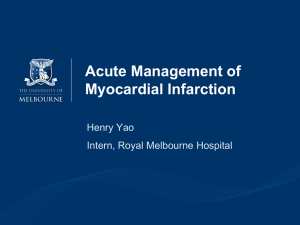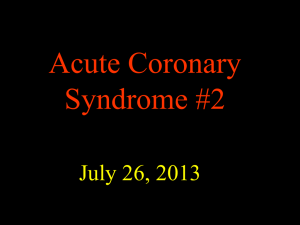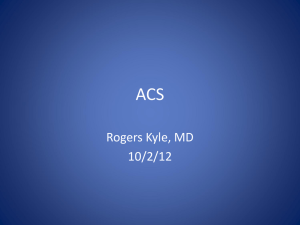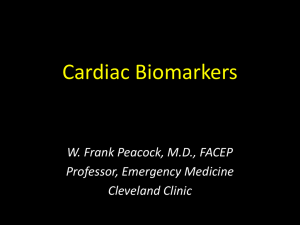presentation (PPT 4.6MB)
advertisement
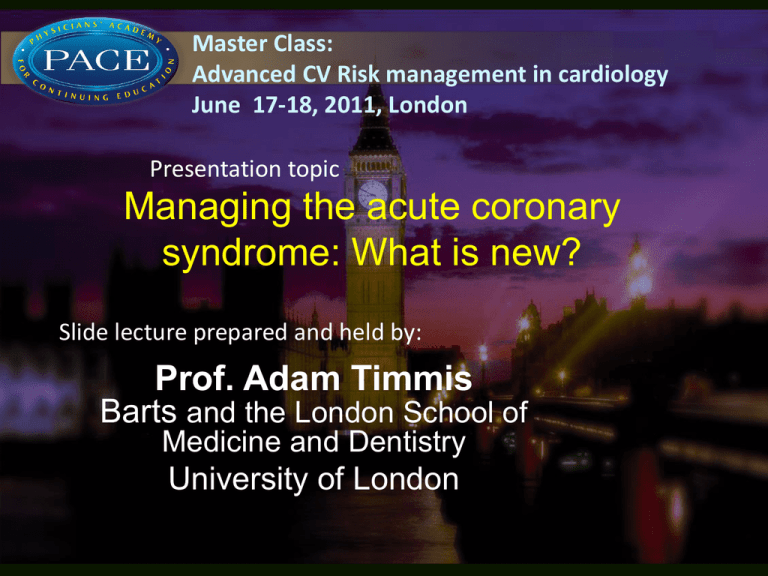
Master Class: Advanced CV Risk management in cardiology June 17-18, 2011, London Presentation topic Managing the acute coronary syndrome: What is new? Slide lecture prepared and held by: Prof. Adam Timmis Barts and the London School of Medicine and Dentistry University of London Declining incidence of Myocardial Infarction Age-sex-adjusted data from Kaiser Permanente CA Age-Sex-Adjusted Incidence of Myocardial Infarction by Year Incidence (per 100 000 person-years) 300 250 Any MI 200 NSTEMI 150 100 STEMI 50 0 1999 2000 2001 2002 2003 2004 Year 2005 2006 2007 2008 Potential drivers of reduced AMI rates Rates of diabetes in patients with 1st AMI • Life-style and risk factors? MINAP data ↓ smoking ↑ diabetes, diagnosed hypertension, dyslipidaemia Outpatient prior to AMI Outpatientmedication Medication Use use Prior to Myocardial Infarction Kaiser Permanente data CA • Medication use? Statin Proportion of Use (%) ↑ all preventive medication 50 40 β-Blocker ACE-I/ARB 30 B-blocker ACEARB 20 Thienopyridine 10 Non-Statin Lipid Lowering 0 1999 2000 2001 2002 2003 2004 2005 2006 Year Outpatient Medication Use Prior to ST-Elevation Myocardial Infarction 2007 2008 What about revascularisation? PTCA vs medical: Cardiac death or myocardial infarction Katritsis, D. G. et al. Circulation 2005 • PCI? “88% of patients believed that PCI would reduce their risk for MI, and 82% believed that it would reduce their risk for death” Rothberg MB et al. Ann Intern Med 2010 Stable angina • CABG? Assessment of the angiographic severity of coronary stenosis is inadequate to accurately predict the time or location of a subsequent coronary occlusion Little et al. Circulation 1988 NSTEMI - 18/12 after RCA, LAD grafts Summary 1. • Rates of AMI declining • Likely consequence of life-style and treatment factors • Revasc non-contributory Life Saving Strategies in AMI 1. Prevent pre-hospital death from 1° VF get the patient to a defibrillator ASAP 2. Prevent hospital death from heart failure initiate reperfusion therapy ASAP 3. Prevent late deaths from a) Recurrent ischaemic events 2° prevention therapy b) Lethal arrhythmias implantable defibrillator 1st episode of VF/1000 pts/hr 33% of people who die from AMI do so before they reach hospital Sayer J Heart 2002 Components of pre-hospital delay in STEMI Frequency distributions using MINAP data for 2004-2005 Time to call for help accounts for most of the variation in pre-hospital delay. Culprits • Older people (>70 yrs) • Women • People with diabetes • Pain onset in early hours • Pain at w/e BHF Doubt Kills Campaign ended October 2007 the message! Summary 2. • 33% of all AMI deaths occur out-of-hospital • Shortening the time to call for help the single most important way to save lives in AMI • Public awareness campaigns never been shown to work Life Saving Strategies in AMI 1. Prevent pre-hospital death from 1° VF get the patient to a defibrillator ASAP 2. Prevent hospital death from heart failure and cardiogenic shock initiate reperfusion therapy ASAP 3. Prevent late deaths from a) Recurrent ischaemic events 2° prevention therapy b) Lethal arrhythmias implantable defibrillator STEMI: reperfusion therapy Primary PCI Adjunctive Antiplatelet Therapy • Aspirin 300mg • Clopidogrel 600mg • ± Abciximab Impact of door to balloon time ACC-NCDR Cath PCI Registry: 2005-2006 (n=43,801) 10.3 (10.0-10.7) 2.9 (2.8-3.1) Rathore BMJ (2010) Culprit only vs complete revascularisation in STEMI: meta-analysis J Thromb Thrombolysis 2011 Complete Revasc • No benefit for mortality • No benefit for recurrent MI • Reduced need for repeat revasc DES vs BMS for primary PCI: metaanalysis of RCTs (n=2786) HR: 0.80 (0.48-1.39) HR: 0.38 (0.29-0.50) Kastrati A et al. Eur Heart J 2007;28:2706-2713 Dual antiplatelet therapy (DAPT) continue for 12 months after DES Refining aspirin/clopidogrel treatment regimens to protect against late thrombosis • Prolonged DAPT for >12 months No effect on 2 yr event rates Park S-J et al. N Engl J Med 2010 • Titrate clopidogrel dose against platelet function testing No effect on 6 month event rates GRAVITAS Investigators. JAMA 2011 • Adjust clopidogrel dose according to genotype Clopidogrel prodrug activated in liver by cytochrome P-450 (CYP) enzymes Carriers of loss-of-function CYP alleles have same event rates as non-carriers Paré G, et al. N Engl J Med 2010 New Inhibitors of the platelet the ADP P2Y12 receptor Receptor Binding Prodrug Half life (requires hepatic activation) Onset of Action Clopidogrel Irreversible Yes Slow Long Prasugrel Irreversible (stronger) Yes More rapid Long Ticagrelor Reversible (stronger) No Rapid Short PLATO: ticagrelor vs clopidogrel in ACS (n=18624) Wallentin L et al. N Engl J Med 2009 Reduced risk of CV events with no increase in bleeding risk 1° PCI: 1 year mortality by baseline CRP and adjunctive treatment with abciximab or placebo. Pooled analysis of 4 ISAAR trials (n=4847) Iijima R et al. Heart 2009; NSTEMI: emergency treatment PCI: moderate high risk 1. Aspirin + clopidogrel ± GP IIb/IIIa inhibitor 2. LMWH - now fondaparinux (factor Xa inhibitor) 3. Anti-ischaemic drugs (BB, nitrates) 4. ± Angiography ± PCI NSTEMI: don’t under-estimate it Prognosis: poor Probability of dying NSTEMI Non-MI ACS STEMI Undertreated Chest Pain ?cause 100 STEMI Days after presentation Treatment rate (%) 90 80 70 NSTEMI 60 50 40 30 Trop -ve ACS 20 10 0 03 Q1 03 Q2 03 Q3 03 Q4 04 Q1 04 Q2 04 Q3 04 Q4 Year and quarter 05 Q1 05 Q2 05 Q3 05 Q4 Trials of Invasive vs Conservative Treatment Strategy in NSTEMI O’Donoghue, M. et al. JAMA 2008;300:71-80 Routine Versus Selective Invasive Strategy in NSTEMI Meta-Analysis of Individual Patient Data (n=5467) CV Death or MI Time to 1st Revasc Procedure Fox, K. A. A. et al. J Am Coll Cardiol 2010 Life Saving Strategies in AMI 1. Prevent pre-hospital death from 1° VF get the patient to a defibrillator ASAP 2. Prevent hospital death from heart failure and cardiogenic shock initiate reperfusion therapy ASAP 3. Prevent late deaths from a) Recurrent ischaemic events 2° prevention therapy b) Lethal arrhythmias implantable defibrillator Adjusted KM curves: 1 yr survival by number of 2° prevention drugs MINAP discharge data NSTEMI and STEMI 2003-2009 0.1 1 0.08 2 0.06 0.04 3 0.02 4 0 0 180 Days after discharge from hospital 360 Impact of under-utilisation: adjusted HRs (95% CI) for death by discharge regimens that exclude key 2° prevention drugs MINAP discharge data NSTEMI and STEMI 2003-2009 Hazard ratio (95% CI) for death GPRD: Continuing statin therapy in 12m post ACS N=6607 linked GPRD-MINAP records Discontinuation of clopidogrel(“noncompliance”) after discharge from hospital Linked MINAP-GPRD registries (n=8445) • Median Duration of therapy: 12m • Hazard of death/AMI – clopidogrel vs no clopidogrel HR 0.57 (0.50-0.65) – discontinuation vs continuation HR 2.62 (2.17-3.17) Summary 4. • 2° prevention therapy - additive beneficial effects on survival • diminishing efficacy probably caused by nonadherence to treatment in primary care • non-adherence to clopidogrel in linked GPRD-MINAP registries more than doubles the risk of recurrent myocardial infarction or death during the first year. Life Saving Strategies in AMI 1. Prevent pre-hospital death from 1° VF get the patient to a defibrillator ASAP 2. Prevent hospital death from heart failure and cardiogenic shock initiate reperfusion therapy ASAP 3. Prevent late deaths from a) Recurrent ischaemic events 2° prevention therapy b) Lethal arrhythmias implantable defibrillator Implantable defibrillator post AMI NICE 2007 2° prevention • Late cardiac arrest VT/VF • Sustained VT with syncope • Sustained VT and LV ejection fraction <35% 1° prevention • AMI >4 weeks previously • LV ejection fraction <30% and QRS >120msec • LV ejection fraction <35% and non-sustained VT on Holter The revolution for coronary outcomes in east London How it was Thrombolysis 2° prevention 1° PCI
